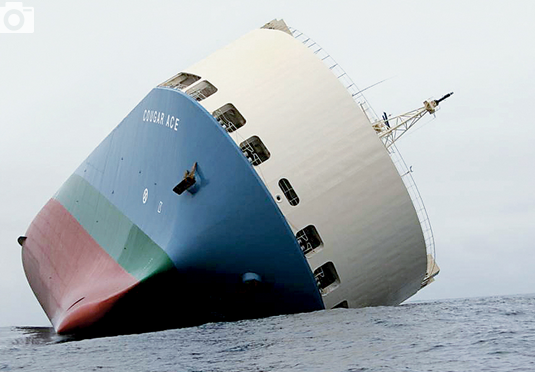The scenario of the ship that refuses to sink is a familiar situation for rescue teams and maritime authorities since the Liberty Ship Flying Entreprise ran adrift in the English Channel in the winter of 1952. A notable difference with the Modern Express is that the master stayed on board till the very end, until he was evacuated, following 15 days of drift and futile efforts to restore the stability of the vessel.
Although relatively recently built, a number of deficiencies have been reported on the Modern Express in the Port of Antwerp since 2012.
The Modern Express has been drifting for 7 days now. The inability of the French and Spanish forces supported by Dutch teams is yet another clear demonstration of the under-equipment in means of salvage. The Bay of Biscay is a busy area for container ships, cargo ships or cruise ships which are twice as long as the Modern Express.
The inventory of toxic materials and cargoes carried on the vessel is not precisely known. The number and size of the heavy construction machinery are also unknown, however they each contain hydrocarbons and other fluids that are toxic to the marine ecosystems; all of which is added to an estimated 300 tons of bunker fuel oil on board the vessel. Similarly, the information regarding the exotic timber cargo from Gabon is unclear; the French Maritime Prefecture in Brest refers to it as sawn timber or logs. About twenty drums are stored on deck. Robin des Bois wishes the full publication of the cargo and hazardous material inventories.
If the Modern Express, only Master on board after God, runs aground by herself, she will stop crosswise a few hundred meters away of beaches. This will make lightering operation, prior to a very unlikely refloating, complicated. In some definitely more favorable circumstances, similar vessels have been pulled out of their delicate situations; such was the case with Hoegh Osaka and Cougar Ace.
 |
 |
| Hoegh Osaka aground near Southampton, United Kingdom, January, 2015.
© UK Marine Accident Investigation Branch |
Cougar Ace, Aleutian Islands, July, 2006.© Kevin Wing |
The in-situ dismantling of the Modern Express will be much more complicated than that of the container ship Rokia Delmas on the Ile de Ré in 2006, of the TK Bremen at Erdeven (Department of Morbihan) in 2012 or of the Luno at Anglet (Department of Pyrénées Atlantiques) in 2014. Beaches and coastal sand dunes of Landes will be exposed to occasional pollution by oil and debris, which will require the immediate deployment of Plan Polmar (French action plan to response accidental marine pollution) as well as the establishment of a restricted security area to ensure that the curious crowds do not trample the sand dunes.
Were the vessel to be taken in tow again, her future trajectory remains a mystery. Currently there are no known ports or places of refuge. Receiving the Modern Express in one of Bilbao or Santander bays or estuaries would be a wonderful opportunity for Spain to make us forget about the massacre of Prestige and her frenetic towing towards the South Atlantic. In a sheltered water body, the recovery of the Modern Express could be seriously considered.
 Imprimer cet article
Imprimer cet article









